

February 2022 Interview with Rick Hwang, President of Rugged & Video Solutions Business Group at Getac

Getac's Mighty Class of 2021
January 2021 Interview with Rick Hwang, President of Rugged & Video Solutions Business Group at Getac

Getac V110 at Cirque du Soleil

Getac 25th Anniversary at 2014 Miramar Air Show

Getac FedEx TechConnect

TDI Panamericana 2011 team using Getac V100 on 16,000 mile endurance challenge
|

|

|
|
Getac's Mighty Class of 2021
An overview of Getac's high-powered trio of tough and rugged tools for work out there in the field: now faster and more powerful than ever before.
by Conrad H. Blickenstorfer
Share on:



When GE-Aerospace and Mitac Corporation founded GETAC at the end of the Reagan era, they may or may not have expected to emerge as a global leader in ruggedized mobile and portable computing innovation for military and other demanding markets worldwide. And yet, here Getac is, with perhaps the most complete and technologically up-to-date roster of rugged tablets and laptops, and over 30 years of experience in building water-tight enclosures, no-vent equipment that scores high in IP and NEMA tests, building and testing to military standard specifications, facilitating resistance to extreme shock, the ability to have machines operate in very wide temperature ranges, making sure they can survive drops, and just generally making computers that can handle dust, sand, snow, water, hazardous materials and whatever else they may encounter.
In this feature, we're highlighting what we're playfully calling "Getac's mighty Class of 2021" — the three most recent or most recently upgraded and overhauled machines out of their round dozen of Getac rugged tablet and Getac rugged laptop computing platforms.
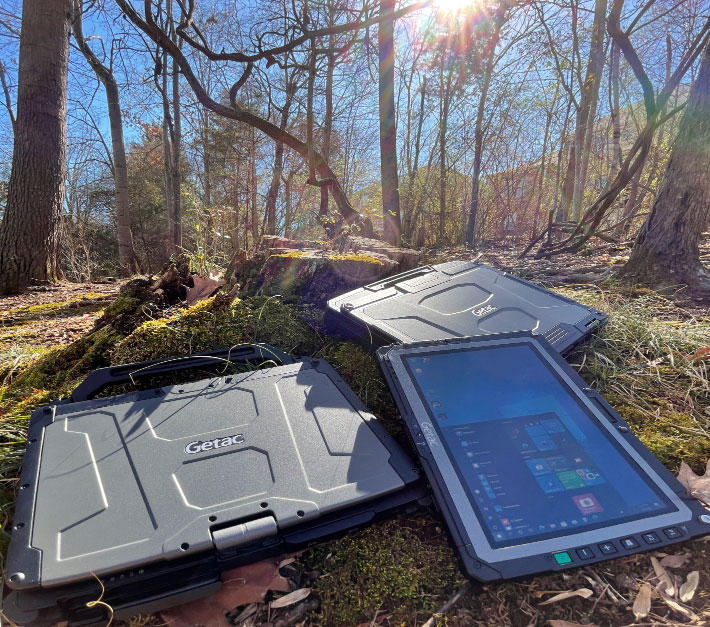
While Getac doesn't have an iconic and instantly recognized brand name like Panasonic's "Toughbook" nor the massive manufacturing capacity of Dell, the company has been duking it out with Toughbooks for almost as long as those existed, outlived erstwhile rival General Dynamics Itronix, and has always had a total focus on rugged technology that's bar none. There's never been a Getac tablet or notebook that was not rugged, and there likely never will. This focus has served Getac well, as has its unwavering commitment to performance and state-of-the-art technology.
In the realm of rugged mobile technology, performance and state-of-the-art tech cannot be taken for granted. It's tough to pack performance into machines that need to be well-sealed, not weigh too much, and still run reasonably long on a charge of the battery pack. And it's tough to stay technologically up-to-date when backward compatibility matters and the lower production runs of rugged gear don't always justify frequent updates and redesigns. Yet, Getac has managed to do just that.
Getac's trio of high performance rugged machines
Getac makes a good number of computers every year, and all of them are rugged. There's a total focus on rugged, and none of Getac's systems are simply retrofitted consumer PCs.
The three machines featured here also show that Getac makes a great effort to keep their various models updated. It's not unusual to find machines in Getac's lineup that are the fourth, fifth or even sixth generation of a platform. Not too long ago, it wasn't unusual in many vertical markets to keep selling products even well after they'd become functionally obsolete. We don't see that much anymore, but there still are machines from major vendors out there that are, for one reason or another, several processor generations behind.
A shining example of how to keep a platform up-to-date is Getac's V110 rugged convertible laptop. Originally launched in 2013, the machine has continually been updated over the years and, as a result, remains as powerful and functional as designs many years younger. The Getac B360 rugged laptop, introduced as a brand-new platform just last year, didn't need any updates. The Getac UX10 rugged tablet was launched in mid-2019 and certainly wasn't obsolete, but Getac substantially updated it anyway.
So below is an overview of the specifics of each of these three platforms:
|
Getac
|
V110 convertible
|
B360/B360 PRO laptop
|
UX10 tablet
|
|
|
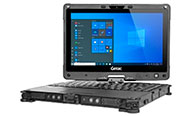
|
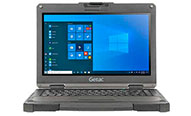
|
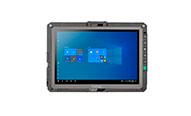
|
|
Device type
|
Fully-rugged convertible laptop
|
Fully-rugged laptop (B360 shown)
|
Fully-rugged tablet
|
|
Display/Resolution
|
11.6" (1,920 x 1,080), 16:9 aspect ratio
|
13.3" (1,920 x 1,080), 16:9 aspect ratio
|
10.1" (1,920 x 1,200), 16:10 aspect ratio
|
|
Display/PPI and Luminance
|
190ppi, 800 (750 in our testing) nits
|
166ppi, 1,400 (1,555 in our testing) nits
|
224ppi, 1,000 (1,005 in our testing) nits
|
|
Operating System
|
Windows 10 Professional
|
Windows 10 Professional
|
Windows 10 Professional
|
|
Intel Processor
|
Core i7-10610U (1.8 GHz, 4.9 GHz turbo)
Core i7-10510U (1.8 GHz, 4.9 GHz turbo)
Core i5-10310U (1.7 GHz, 4.4 GHz turbo)
Core i5-10210U (1.6 GHz, 4.2 GHz turbo)
|
Core i7-10710U (1.1 GHz, 4.7 GHz turbo)
Core i7-10610U (1.8 GHz, 4.9 GHz turbo)
Core i7-10510U (1.8 GHz, 4.9 GHz turbo)
Core i5-10310U (1.7 GHz, 4.4 GHz turbo)
Core i5-10210U (1.6 GHz, 4.2 GHz turbo)
|
Core i7-10610U (1.8 GHz, 4.9 GHz turbo)
Core i7-10510U (1.8 GHz, 4.9 GHz turbo)
Core i5-10310U (1.7 GHz, 4.4 GHz turbo)
Core i5-10210U (1.6 GHz, 4.2 GHz turbo)
|
|
Cores/threads
|
Core i7-10610U: 4/8
Core i7-10510U: 4/8
Core i5-10310U: 4/8
Core i5-10210U: 4/8
|
Core i7-10710U: 6/12
Core i7-10610U: 4/8
Core i7-10510U: 4/8
Core i5-10310U: 4/8
Core i5-10210U: 4/8
|
Core i7-10610U: 4/8
Core i7-10510U: 4/8
Core i5-10310U: 4/8
Core i5-10210U: 4/8
|
|
Thermal Design Power
|
15.0 watts
|
15.0 watts
|
15.0 watts
|
|
RAM
|
8 to 64GB DDR4
|
8 to 64GB DDR4 in 2 slots
|
8 to 32GB DDR4 in 2 slots
|
|
Primary Storage
|
256GB to 1TB PCIe NVMe SSD
|
256GB to 1TB PCIe NVMe SSD
|
256GB to 1TB PCIe NVMe SSD
|
|
Secondary Storage
|
NA
|
2nd 256GB to 1TB SATA SSD
|
NA
|
|
Mass storage types
|
PCIe NVMe
|
PCIe NVMe, SATA
|
PCIe NVMe
|
|
Standard Battery
|
2 x 22.9 Whr Li-Ion
|
2 x 23.3 Whr Li-Ion
|
1 x 46.6 Whr Li-Ion
|
|
Optional Battery
|
NA
|
2 x 74.5 Whr Li-Ion (B360 Pro)
|
1 x 99.4 Whr Li-Ion
|
|
Size
|
12.32 x 9.37 x 1.53 inches
|
13.46 x 11.06 x 1.37 inches
|
10.89 x 7.65 x 0.92 inches
|
|
Weight
|
from 4.6 lbs
|
from 5.1 lbs
|
from 2.7 lbs
|
|
Media Bay
|
No
|
Yes
|
No
|
|
Smart Card reader
|
Yes
|
Yes
|
Optional
|
|
Operating drop
|
4 feet operating
|
6 feet operating
|
6 feet operating
|
|
Operating temp
|
-20° to 145°F
|
-20° to 145°F
|
-20° to 145°F
|
|
Ingress protection
|
IP65
|
IP66
|
IP65
|
|
Salt Fog protection
|
Optional
|
Optional
|
No
|
|
I/O protection
|
Slide-lock protective ports
|
Slide-lock protective ports
|
Slide-lock protective ports
|
|
Cameras
|
FHD webcam or IR camera
|
FHD webcam or IR camera
|
FHD webcam or IR camera
|
|
Starting price
|
Inquire
|
Inquire
|
Inquire
|
|
See on the web
|
Getac V110 webpage
|
Getac B360 Pro webpage
|
Getac UX10 webpage
|
|
Spec sheet
|
Getac V110 specs
|
Getac B360 Pro specs
|
Getac UX10 specs
|
We hope the above table shows the nature, purpose and capabilities of these three very different rugged computers from Getac: a tablet, a convertible laptop, and a full-size and greatly expandable traditional laptop, all three with numerous applications in the field.
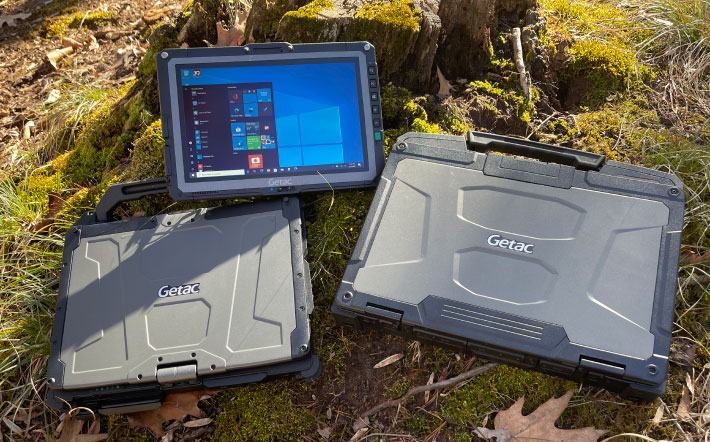
State-of-the-art tech under the hoods
Let me preface with the obvious: the term "state-of-the-art" is as fleeting as time itself. Here today, gone tomorrow. Each of these three machines began life as technologically up-to-date as was feasible. The V110 convertible laptop, for example, launched with a lineup of 4th generation "Haswell" processors back in 2013. That would be hopelessly obsolete today. Yet, a future-oriented design and meticulous updating means the latest V110 right up there in terms of performance with the latest rugged machines.
Time, of course, moves on. Intel's 11th generation of Core processors is already upon us and will become increasingly available. On the other hand, some machines from major competitors are still at the 7th or 8th generation of Core processors. Those machines will eventually either be dropped or updated. It's an ongoing game of leapfrogging and that won't change anytime soon.
High performance doesn't just mean the latest chips and tech; reliable operation and highest possible performance also require careful thermal management. Below you can see a couple of infrared pictures of a Getac B360 taken with our Flir ONE Pro thermal imaging camera. The images show how what we assume is copper heat piping conducts heat away from the processor and other heat generating electronics to the heat exchanger/fan assembly. This way, even while running performance benchmarks, the exhaust air consistently stayed in the low 80F range. Over the years Getac has had both fanless and fan-cooled models. The three machines covered in this feature all use a small fan. The advantage of fans is that they can actively manage temperature, thus preventing performance drop-offs and maximizing turbo speed operation.
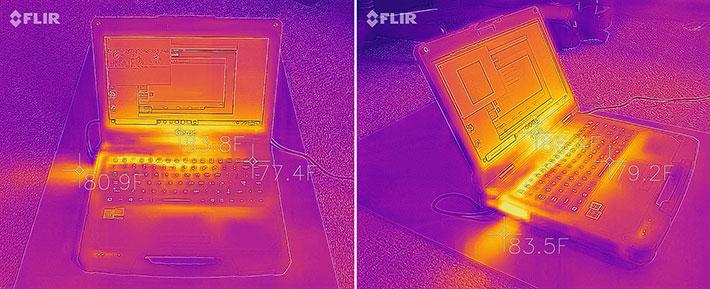
 What makes these three rugged Getac machines so state-of-the-art? In part, of course, Getac's decades of expertise in designing and building rugged computers. But it's more than that. Getac not only made available Intel's latest feasible processors (10th generation "Comet Lake") but also the highest performance storage technology (PCIe NVMe instead of the increasingly dated SATA). That combination packs a massive punch. What makes these three rugged Getac machines so state-of-the-art? In part, of course, Getac's decades of expertise in designing and building rugged computers. But it's more than that. Getac not only made available Intel's latest feasible processors (10th generation "Comet Lake") but also the highest performance storage technology (PCIe NVMe instead of the increasingly dated SATA). That combination packs a massive punch.
How fast are these three rugged Getac machines? The Getac B360 Pro with the NVIDIA GTX1050 optional discrete graphics is the overall fastest machine we ever tested in the RuggedPCReview Lab PassMark 9.0 benchmark, and the other two aren't far behind.
|
Getac 2021 comparisons and benchmarks
|
|
|
Getac
|
Getac
|
Getac
|
|
Model
|
UX10 tablet
|
V110 convertible
|
B360 PRO laptop
|
|
Processor Type: Intel
|
10th gen "Comet Lake"
|
10th gen "Comet Lake"
|
10th gen "Comet Lake"
|
|
Processor Model
|
Core i7-10510U
|
Core i7-10510U
|
Core i7-10710U
|
|
CPU Speed
|
1.80GHz
|
1.80GHz
|
1.10GHz
|
|
Turbo Speed
|
4.90GHz
|
4.90GHz
|
4.70GHz
|
|
CPU Cores/threads
|
4/8
|
4/8
|
6/12
|
|
Thermal Design Power (TDP)
|
15 watts
|
15 watts
|
15 watts
|
|
Graphics
|
Intel UHD 10th gen
|
Intel UHD 10th gen
|
UHD 10th gen + NVIDIA GTX1050
|
|
BatteryMon min draw
|
2.4 watts
|
2.5 watts
|
2.2 watts
|
|
PassMark version
|
v6.1
|
v9.0
|
v6.1
|
v9.0
|
v6.1
|
v9.0
|
|
CPU Mark
|
10,582.4
|
9,026.3
|
8,396.0
|
8,117.7
|
9,546.0
|
9,788.5
|
|
2D Graphics Mark
|
452.4
|
653.6
|
408.9
|
648.4
|
430.8
|
675.7
|
|
Memory Mark
|
1,995.1
|
2,357.0
|
1,815.8
|
2,309.9
|
4,879.3
|
2,576.7
|
|
Disk Mark
|
16,299.0
|
21,551.9
|
13,556.9
|
15,224.2
|
14,090.2
|
21,116.1
|
|
3D Graphics Mark
|
728.9
|
1,099.3
|
730.3
|
1,094.0
|
801.3
|
3,026.3
|
|
Overall PassMark
|
6,627.0
|
3,596.7
|
5,450.0
|
3,467.3
|
6,430.2
|
4,531.8
|
|
Overall PC Mark 10
|
3,869
|
3,780
|
4,265
|
|
PC Mark 10 Essentials
|
8,439
|
8,200
|
9323
|
|
PC Mark 10 Productivity
|
6,304
|
6,645
|
7,356
|
|
PC Mark 10 Dig. Content Creation
|
2,956
|
2,690
|
3,070
|
|
PC Mark 10 Drive
|
1,949
|
1,590
|
1,825
|
|
3DMark (Time Spy)
|
414
|
393
|
1,520
|
|
GeekBench 5 Single Core
|
1,123
|
1,090
|
1,238
|
|
GeekBench 5 Multi Core
|
2,839
|
2,837
|
4,187
|
Note that in order for RuggedPCReview.com readers to better be able to compare performance results seen elsewhere, we have added three of the most popular benchmark suites, those being UL's PC Mark 10 and 3D Mark as well as Geekbench 5.
These benchmark results are tremendous and show that, in the pursuit of offering customers the highest possible performance, Getac understands the importance of not just tweaking individual subsystems of a computer, but all of them. 10th gen Core processors are now becoming available in some high-end rugged systems, but not always in conjunction with the equally important switch to super-fast PCIe NVMe-based storage.
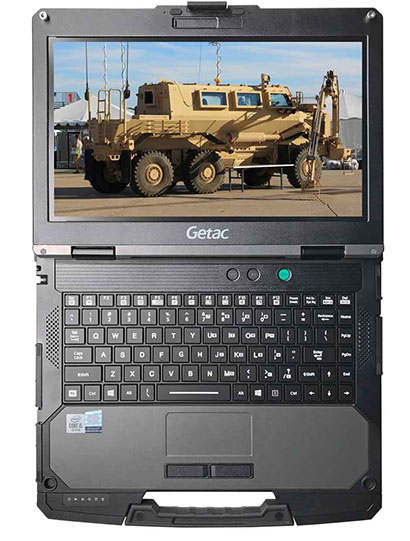 What makes the mobile 10th generation of Core processors so special?
It is Intel's first-ever generation to include a six-core/twelve-thread high-end mobile chip design. That's yet another step up from the availability of quad-core chips that pioneered in the 8th generation (there are quad-core chips in Intel's lower end lines, but at a much lower performance level). What makes the mobile 10th generation of Core processors so special?
It is Intel's first-ever generation to include a six-core/twelve-thread high-end mobile chip design. That's yet another step up from the availability of quad-core chips that pioneered in the 8th generation (there are quad-core chips in Intel's lower end lines, but at a much lower performance level).
Four core designs aren't necessarily twice as fast as two cores, and neither are six cores automatically half again as fast as four. That's because program code cannot always keep multiples cores busy, but in our testing, quad-core chips have been faster than dual-core designs.
Overall, the jury's still out on the performance advantage six-core designs have over four-core chips. Being the only one with the six-core i7-10710U chip, the B360 Pro was the fastest in this lineup but it was also the only one that benefitted from a discrete GPU, so it wasn't quite comparing apples to apples.
But won't more cores consume more battery power? They most likely would if they always ran at the same clock speed as processors with fewer cores. As is, ever since Intel introduced four-core designs, those have been idling along at significantly lower base clock speeds than earlier dual-core designs, without a loss of performance and without higher battery draw.
And now we're seeing the same with the six-core i7-10710U that has a default clock speed of just 1.1GHz versus 1.8GHz for the four-core i7-10510U. As a result, the big Getac B360 with its six-core processor and largest screen in the lineup actually had the lowest minimum power draw, just 2.2 watts in our PassMark BatteryMon testing.
As far as storage goes, after having been preaching the gospel of PCIe NVMe-based over SATA-based mass storage ever since we first witnessed its blistering speed in a 2017 Motion R12 tablet, most new high-end rugged tablets and laptops have it, including these three Getac machines.

But now let's take a look at each of the three models separately.
The Getac UX10 — tablet and more
Getac initially introduced the UX10 in mid-2019 as a rugged 10-inch tablet designed to meet the challenges faced by emergency service and public safety personnel around the world, but suitable for numerous other demanding applications in utilities, field services, industrial manufacturing and more. The UX10 is a very flexible device that can be used either as a stand-alone tablet or, in conjunction with an excellent optional value-added keyboard dock, as a full-function laptop (see picture below). Launched with Intel 8th generation Core processors, the updated UX10 now shines with an all quad-core 10th generation Intel Core processor lineup of available CPUs. And the switch from the original SATA storage to much faster PCIe NVMe storage boosts performance even more.
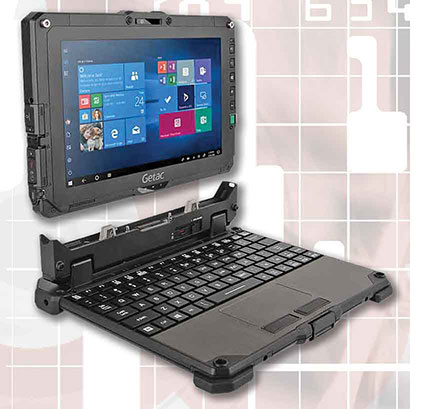 The UX10 initially seemed like Getac's answer to the Panasonic Toughbook 20, just like Getac's larger K120 seemed launched to compete with Panasonic's Toughbook 33 2-in-1. All are hybrid solutions consisting of a self-contained tablet and an optional detachable keyboard that contains considerable additional functionality and connectivity. Panasonic calls theirs a detachable laptop whereas Getac bills the UX10 as a rugged tablet with enhanced versatility. The UX10 initially seemed like Getac's answer to the Panasonic Toughbook 20, just like Getac's larger K120 seemed launched to compete with Panasonic's Toughbook 33 2-in-1. All are hybrid solutions consisting of a self-contained tablet and an optional detachable keyboard that contains considerable additional functionality and connectivity. Panasonic calls theirs a detachable laptop whereas Getac bills the UX10 as a rugged tablet with enhanced versatility.
With the latest performance updates, the Getac UX10, which had already started out at a much higher performance level than the Toughbook 20, is now way ahead of its competitor that remains powered by 7th generation Core Y-Series processors.
The UX10 display (which is of the IPS variety, as all recent Getacs) measures 10.1 inches diagonally and offers 1920 x 1200 pixel resolution, making for a sharp 224 pixels per inch. Its 1000 nits luminance is higher than the Panasonic Toughbook 20's 800 nits. There's, of course, 10-point capacitive multi-touch, a hard tip stylus, and an optional active digitizer.
As far as connectivity goes, Getac made the UX10 as configurable as possible so it can meet the specialized needs of its intended customers. Basic onboard I/O includes a USB 3.1 Gen 2 Type A port, HDMI, the headphone jack, and the docking connector. Additional I/O functionality can be ordered via an expansion slot that can accommodate a serial port, another USB Type A or Type C port, RJ45 LAN, VGA, or a barcode or HF RFID reader. Note though that it's either/or; only one of the above can be installed in that slot.
Due to weight and space issues, battery capacity is always a tricky thing with tablets. Here, Getac didn't follow the recent trend of offering devices with two tiny batteries just to be able to claim a very low starting weight with only one battery installed. Instead, the Getac UX10 comes with an adequately sized 46.6 watt-hour battery, and also offers an optional 99.8 watt-hour long-lasting battery. Hot-swapping is still possible with an optionally available bridge battery.
The composite below shows what the Getac UX10 looks like with its optional carry handle and fingerprint reader installed, from the front and from all four sides:

Given its intended deployments, the UX10's emphasis is more on functionality and performance than lowest possible size and weight. The tablet/keyboard combo weighs about 4.6 pounds, but the tablet alone weighs just 2.7 pounds.
Despite its light weight, the Getac UX10 feels tough and substantial. It's an elegant, purposeful design where form follows function. The tablet shape looks like it was designed to accommodate screw-on corner bumpers, and maybe those are available.
Sealing and protection of ports is of tantamount importance in rugged computers. Getac knows that and gave the UX10 elaborate sealed snap-click protective doors. They consist of an inner seal with a rubber lip around it, and an outer polycarbonate door that is then pushed down for a very secure, tight seal and fit. You have to be careful to get them snap into place the proper way, but once you get the hang of it, it's a good, reliable solution. Below is a look at the top side of the Getac UX10, showing the optional handle and integrated bar code scanner:

Below a look at the backside of a fully-equipped Getac UX10. Overall, the highly configurable tablet has three expansion areas, with each one accommodating one of several expansion options.
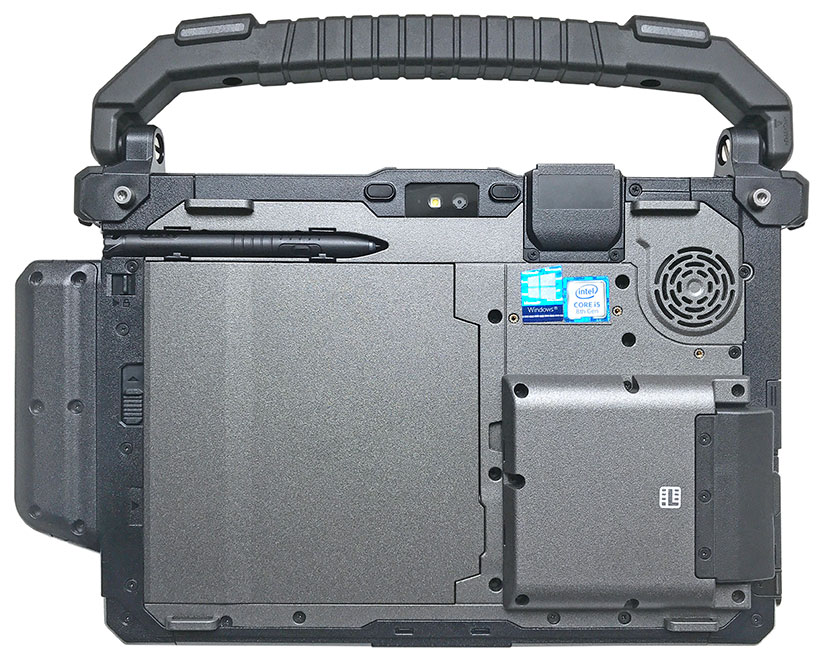 On the one hand, this approach makes the UX10 customizable to suit a very large number of possible applications. On the other hand, since each of the three expansion areas can only accommodate ONE of the available options, customers still might have to make some hard choices. On the one hand, this approach makes the UX10 customizable to suit a very large number of possible applications. On the other hand, since each of the three expansion areas can only accommodate ONE of the available options, customers still might have to make some hard choices.
Overall, the Getac UX10 hits the sweet spot for a large number of potential applications. It has a display larger than those of even the biggest smartphones, but still small enough to go anywhere. With its selection of 10th generation Intel Core processors, the UX10 is plenty powerful enough for any application, yet it also runs a long time on a single charge.
A highly modular design with three expansion areas allows easy customization for virtually any type of deployment. A bright, vibrant display makes the UX10 easily suitable for outdoor work. A broad catalog of accessories enhances productivity and allows for easy use in vehicles, in the field, or in the office. Impressive ruggedness means the UX10 can go where no consumer tablet can.
The Getac UX10 is a primary example of the difference between fragile consumer tech and ruggedized technology that can be trusted on the job, no matter how hard the job is, or where it takes place.
The Getac V110 — convertible laptop
The Getac V110 is a convertible laptop. The idea of combining laptop and tablet functionality has been around for a long time, going back to the earliest pen tablet computers of the early 1990s. The rotating hinge design used on the V110 made its entrance with Microsoft's 2002 Tablet PC initiative of 2002 when Acer and Toshiba used it. Panasonic soon followed with the original Toughbook 18. Getac added their V100 in 2007, followed by the larger V200 in 2012. Both were replaced in 2013 by the original V110.
How does this type of convertible laptop work? It's simple. The LCD case of the notebook has a single rotating hinge located in the bottom center, allowing the screen to be turned around so that the laptop can be closed with the LCD facing up. This way it can be used either as a notebook or as a tablet (albeit a fairly thick one by modern consumer tablet standards). The sequence below shows the quick transformation from laptop to tablet.

The Getac V110 is a very rugged laptop that provides flexibility and substantial computing power in a compact package. Its footprint of 11.8 x 8.8 inches is barely larger than that of a sheet of paper. Despite its ruggedness and sturdy build, it's just an inch and a third thick and weighs just a bit over four pounds. The V110's keyboard is 100%-scale, making typing easy and comfortable.
The composite below shows what the Getac V110 looks like from the top and from all four sides:
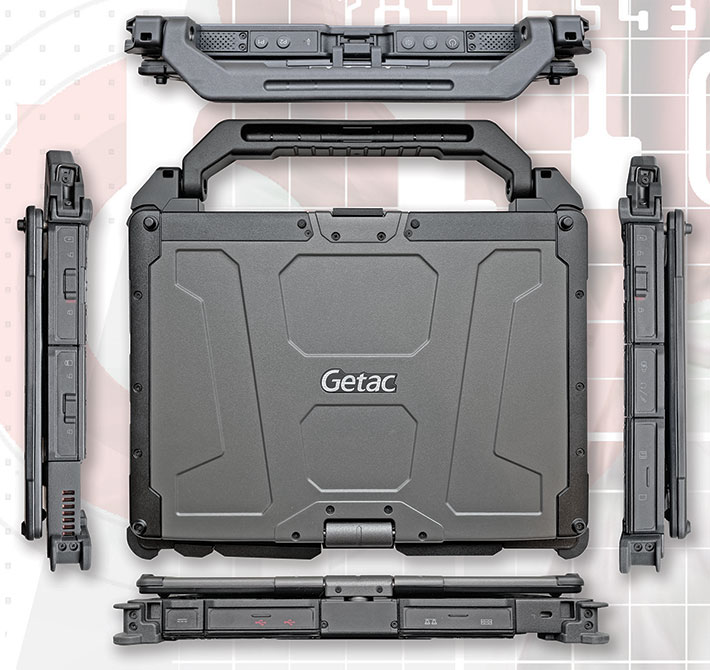
These days we're seeing more "2-in-1" hybrid designs than convertible laptops like the V110. The argument against the V110 is that in this era of super-slender tablets convertibles are simply too thick and heavy to be of much use as tablets. The argument for the V110 is that Windows 10 has grown into a very usable capacitive touch tablet OS, which makes tablet functionality much more valuable than it once was. Perhaps more importantly, most pure tablets have very little onboard I/O. The V110 has A LOT:

There aren't many rugged tablets that have two easily replaceable batteries, a quickly removable solid state PCIe NVMe disk module (up to 1TB), three USB 3.2 Type-A ports, an RJ45 LAN jack, HDMI, a legacy DB9 serial port, a 3.5mm audio in/out jack, a Smart card reader and even an optional barcode reader or reversible USB Type-C port.
State-of-the-art wireless communication is crucial in a mobile computing device, be that in the office or out there on the road or in the field. Dell covers that with either Intel or Qualcomm 802.11ac modules that can also include Bluetooth 4.1.
And even though the Getac V110 is a "classic" design and the machine has been around for many years, the guts are all brand-spanking new technology, the same Intel 10th generation Core processors, the same Intel AX200 802.11ax Wi-Fi 6, Bluetooth v5.2, PCIe NVMe storage, DDR4 RAM, and optional dedicated GPS and 4G LTE mobile broadband as Getac's newest machines. And just about the same top-notch performance as well.
The Getac B360 — fully-rugged laptop reinvented
For all practical purposes, the Getac B360 is the modern day version of the traditional all-purpose rugged laptop that Panasonic initially pioneered in the 1990s. And with the new B360, Getac actually offers something that its main rival, Panasonic, doesn't currently have: a modern, state-of-the-art full-size, fully rugged laptop that isn't bulky and doesn't weigh a ton.
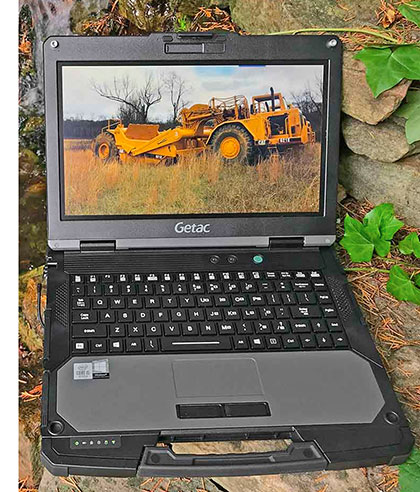
Where does the new Getac B360 fit into the rugged laptop landscape? Given its "B360" designation, you'd think it might be a direct replacement for Getac's long-time rugged laptop standard bearer, the B300, but it's not. That old warhorse was designed specifically to take on the original Panasonic Toughbook, heavy build and square-ish 4:3 screen aspect ratio and all. That rivalry, however, came to an end, each venerable platform having yielded to lighter and more modern designs.
Is the new B360 then taking on the new guard of lighter, thinner more modern laptops, like the Panasonic Toughbook 55, the Dell Latitude 5420 Rugged or the Durabook S14I?
That's much closer, with each of those machines pretty much the same size and weight as the new B360. But it'd still be comparing apples and oranges because those machines are all semi-ruggeds with only moderate ingress protection and drop specs. Whereas the Getac B360 is a fully rugged machine with IP66 sealing and a most impressive 6-foot drop spec.
What does that mean? In essence that Getac baked full and not just "semi" ruggedness into the B360 even though it has the footprint, thin profile and low weight of a semi-rugged. That is quite remarkable.
But Getac didn't stop even there. It also leapfrogged the competition by equipping the B360 with the very latest Intel 10th generation processors and the tech that goes with it, by far the brightest screen, that superfast PCIe NVMe solid state disk technology, and more. A new benchmark for sure. And this is what the Getac B360 looks like from all sides:
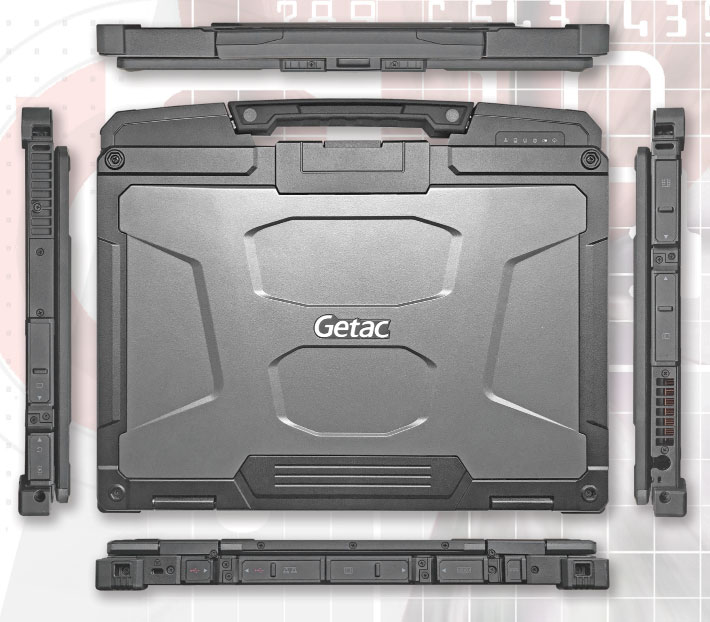
But that's still not all. Getac knows that some applications require a powerful laptop that's as light and handy as possible, whereas other applications need as much onboard I/O as possible and also as much expansion potential as possible, even if that means extra size and weight.
And that's why there's the remarkably light and slender Getac B360 and also the Getac B360 PRO. The B360 and the B360 PRO are essentially the same computer, but the B360 PRO sits on a "basement" that provides space for extra functionality and adds about 3/4 of an inch in height an 1.6 pounds in weight.
The B360 PRO adds these options:
- A discrete graphic controller (NVIDIA GTX1050) or a PCMCIA Type II card slot or an Express Card/54 card slot
- A DVD super multi drive or a Blu-Ray super multi drive
- An additional serial port
Perhaps most importantly, while the standard B360's two batteries combine for just 46.6 watt-hours, the B360 PRO comes with two much beefier 74.5 watt-hour batteries for a total of 149 watt-hours, more than tripling battery capacity.
The composite below shows what the Getac B360 PRO looks like from the top and from all four sides:
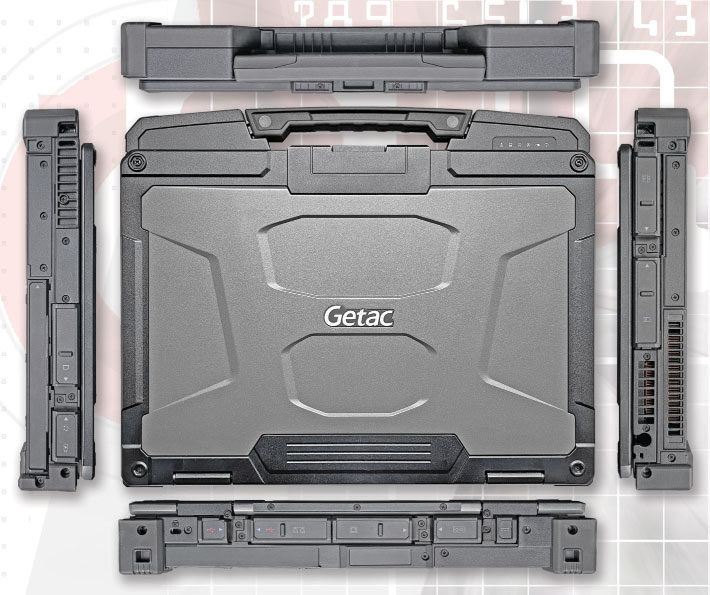
As you can see, while the B360 PRO has the exact same footprint and design as the B360, it is a thicker, heavier machine with additional features that may be absolutely required by some customers but not by others. This is the same approach that rival Dell took with its rugged laptops where the Latitude 5420 Rugged emphasizes minimal size and weight, and the Latitude 5424 and 7424 are thicker and weigh more, but also offer significant additional features.
Good outdoor/sunlight viewability is of importance to users of rugged laptops like the Getac B360 or B360 PRO. Getac has long been a leader in this category with their "QuadraClear™" display technology (see here). The term refers to the technology's four core features: a bright backlight, anti-reflective coatings, linear polarizer, and circular polarizer.
With a listed luminance of 1400 nits the Getac B360/B360 PRO display is very bright (we even measured it at 1,555 nits) while the various optical treatments cut down the percentage of incoming ambient light. That's important because the ratio between the backlight and the reflected incoming ambient light determines the effective contrast ratio, which then translates into the degree of real world outdoor readability of a display. What's also important is the type of the optical coatings, how they are applied and how the various layers are bonded. Getac calls their layer bonding process "LumiBond®" (see here).
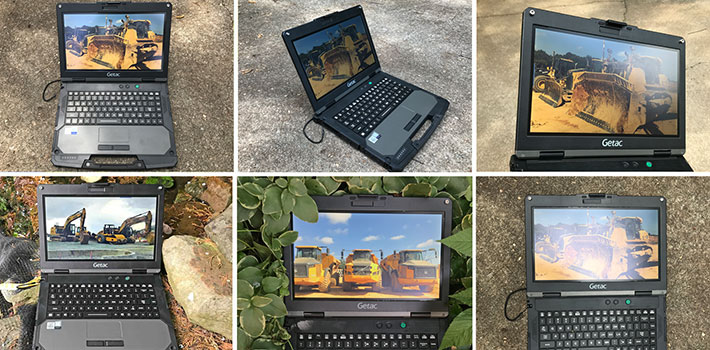
The Getac B360 and B360 PRO are fully rugged machines and designed to reliably perform under extreme working environments where weather conditions and physical abuse are an ever-present reality. The machine can operate between -20° and 145° Fahrenheit (-29° to 63°C). Sealing is at the IP66 standard, and the machine fills MIL-STD-810H testing requirements for humidity, altitude, shock, drop, vibration and others, and the B360 is also compliant with MIL-STD-461G (electromagnetic interference). The pictures below show samples of the kind of ruggedness testing Getac performs on all of their computers.
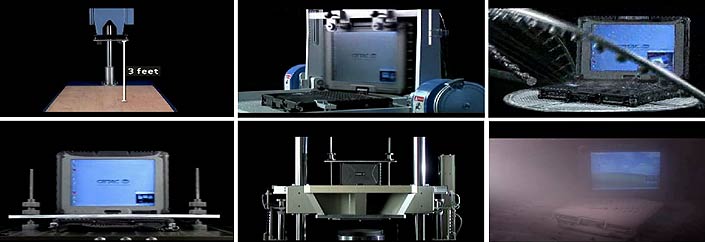
To go into a bit more detail on the individual ruggedness testing categories:
IP ratings refer to Ingress Protection standards for electrical enclosures, with the first number describing the protection level against solids and the second protection against liquids. The B360's IP66 rating indicates total protection against dust, and the laptop is also protected against strong jets of water from all directions. That is far above semi-rugged laptops' IP52 or IP53 ingress protection ratings.

In terms of temperature resistance, the B360's extremely wide -20 to 145 degrees Fahrenheit operating temperature range was measured in accordance with MIL-STD-810H, 501.5 Procedure II and 502.5 Procedure II. The computer also passed non-condensing humidity testing up to 95% per MIL-STD-810H, 507.5 Procedure II, and can operate in altitudes up to 15,000 feet (and obviously in aircraft with pressurized cabins) per MIL-STD-810H, 500.5 Procedure II.
The device is RoHS-compliant. RoHS stands for Restriction of Hazardous Substances and regulates the use of certain hazardous substances in electronic equipment. The RoHS standard is fully implemented in Europe, with lesser restrictions applying in the US.
Shock, vibration, drop and ESD resistance are all tested according to MIL-STD-810H and other relevant regulatory procedures. Not all results are in the promotional literature or owner's manual (which for now only states "vibration & drop resistant"), so inquire with Getac for specifics and also check Getac's MIL-STD-810 compliance testing list (see here).
With respect to the ever important drop spec, Getac's web page specs don't mention a particular drop height, just that the tests performed on Getac units include MIL-STD-810H Method 516.6. — transit drop. That one generally requires 26 drops from four feet. Why four feet? Because when designing the drop tests, the government figured that if you drop something while standing, it'll drop about four feet, as opposed to something that falls off a table or counter, which is 2.5 to three feet. Getac, however, informed us that the B360 has passed the tests from a drop height of six feet. That is impressive.
I should mention that optionally available is ANSI/UL 121201, CSA C22.2 NO. 213 certification as electrical equipment for use in Class I, Division 2 hazardous locations (i.e. places where ignitable concentrations of flammable gases, vapors or liquids may happen). There are multiple configuration options to fit desired usage scenarios in potentially explosive environments typically found in the oil and gas, petrochemical, aviation and related industries.
Finally, Getac's rugged mobile computer decontamination document (see here) recommends a number of commonly available disinfectants for the B360. Those have all been tested for 10,000 swipe-downs at a pressure of 14.22 psi.
Summary: Getac's Mighty Class of 2021
So this is Getac's mighty Class of 2021 — three terrific machines, each having a different purpose and focus, and filling different needs. The Getac B360 and B360 PRO, state-of-the-art modern versions of the quintessential rugged laptop, and currently the highest performing rugged machines we've ever tested. The Getac UX10, a thoroughly modern 2.7-pound Windows tablet that brings desktop performance into the field and doubles as a handy laptop with its optional detachable keyboard that contains additional functionality and connectivity. And the Getac V110, a laptop convertible that's been around for a many years, all updated to 2021 speed and technology.
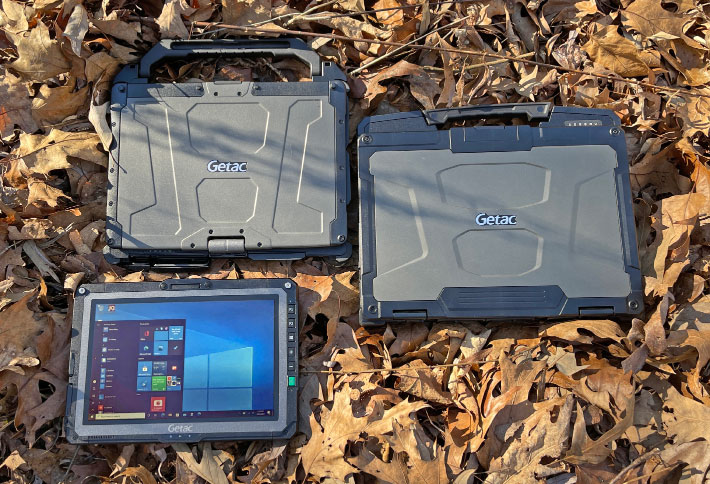
These three, of course, aren't all that Getac offers. There are two more rugged laptop platforms (the semi-rugged Getac S410 and the high-end workstation and server class X500) and also six more rugged tablets (the A140, EX80, F110, K120, T800 and ZX70). The trio, however, is a prime example of the kind of consistent excellence that comes from decades of experience and leadership in a field and also from a clearly defined mission and focus. -- Conrad H. Blickenstorfer, March 2021
 FAST. SECURE. RUGGED.
FAST. SECURE. RUGGED.
|
|
|
|












